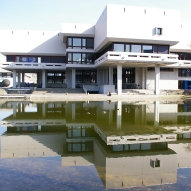| Dokumentenart: | Artikel | ||||
|---|---|---|---|---|---|
| Titel eines Journals oder einer Zeitschrift: | Molecular & Cellular Proteomics | ||||
| Verlag: | AMER SOC BIOCHEMISTRY MOLECULAR BIOLOGY INC | ||||
| Ort der Veröffentlichung: | BETHESDA | ||||
| Band: | 15 | ||||
| Nummer des Zeitschriftenheftes oder des Kapitels: | 2 | ||||
| Seitenbereich: | S. 462-480 | ||||
| Datum: | 2015 | ||||
| Institutionen: | Medizin > Lehrstuhl für Humangenetik | ||||
| Identifikationsnummer: |
| ||||
| Stichwörter / Keywords: | OXYGEN-INDUCED RETINOPATHY; COMBINED TRANSMEMBRANE TOPOLOGY; SIGNAL PEPTIDE PREDICTION; LABEL-FREE; AUTOIMMUNE UVEITIS; MASS-SPECTROMETRY; OXIDATIVE STRESS; MOUSE RETINA; RAT RETINA; MICROGLIAL ACTIVATION; | ||||
| Dewey-Dezimal-Klassifikation: | 600 Technik, Medizin, angewandte Wissenschaften > 610 Medizin | ||||
| Status: | Veröffentlicht | ||||
| Begutachtet: | Ja, diese Version wurde begutachtet | ||||
| An der Universität Regensburg entstanden: | Ja | ||||
| Dokumenten-ID: | 41950 |
 Web of Science
Web of ScienceZusammenfassung
To date, the proteomic profiling of Muller cells, the dominant macroglia of the retina, has been hampered because of the absence of suitable enrichment methods. We established a novel protocol to isolate native, intact Muller cells from adult murine retinae at excellent purity which retain in situ morphology and are well suited for proteomic analyses. Two different strategies of sample ...

Zusammenfassung
To date, the proteomic profiling of Muller cells, the dominant macroglia of the retina, has been hampered because of the absence of suitable enrichment methods. We established a novel protocol to isolate native, intact Muller cells from adult murine retinae at excellent purity which retain in situ morphology and are well suited for proteomic analyses. Two different strategies of sample preparation-an in StageTips (iST) and a subcellular fractionation approach including cell surface protein profiling were used for quantitative liquid chromatography-mass spectrometry (LC-MSMS) comparing Muller cell-enriched to depleted neuronal fractions. Pathway enrichment analyses on both data sets enabled us to identify Muller cell-specific functions which included focal adhesion kinase signaling, signal transduction mediated by calcium as second messenger, transmembrane neurotransmitter transport and antioxidant activity. Pathways associated with RNA processing, cellular respiration and phototransduction were enriched in the neuronal subpopulation. Proteomic results were validated for selected Muller cell genes by quantitative real time PCR, confirming the high expression levels of numerous members of the angiogenic and anti-inflammatory annexins and antioxidant enzymes (e. g. paraoxonase 2, peroxiredoxin 1, 4 and 6). Finally, the significant enrichment of antioxidant proteins in Muller cells was confirmed by measurements on vital retinal cells using the oxidative stress indicator CM-H2DCFDA. In contrast to photoreceptors or bipolar cells, Muller cells were most efficiently protected against H2O2-induced reactive oxygen species formation, which is in line with the protein repertoire identified in the proteomic profiling. Our novel approach to isolate intact glial cells from adult retina in combination with proteomic profiling enabled the identification of novel Muller glia specific proteins, which were validated as markers and for their functional impact in glial physiology. This provides the basis to allow the discovery of novel glial specializations and will enable us to elucidate the role of Muller cells in retinal pathologies-a topic still controversially discussed.
Metadaten zuletzt geändert: 17 Mrz 2020 11:02




 Altmetric
Altmetric